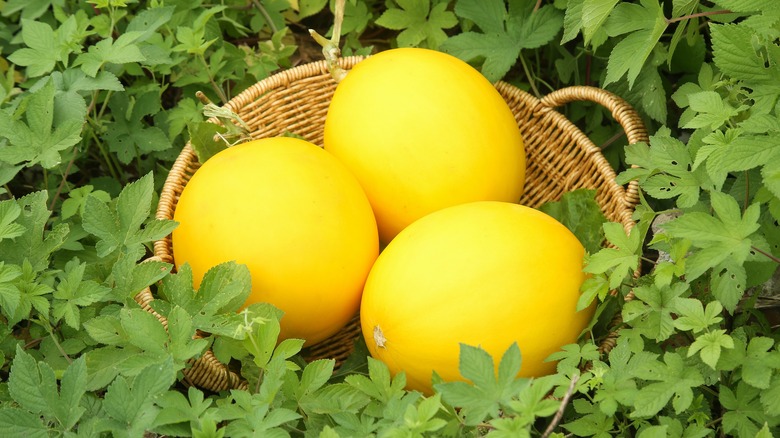How To Grow The Juiciest Honeydew Melon In Your Summer Garden
If your garden basks in full sun, it's the perfect spot for honeydew melons. They can be grown in USDA Hardiness Zones 4 through 11 and thrive in warm to hot conditions. Your reward is smooth, sweet fruit by late summer. Honeydews need a long growing season, about 100 to 120 days from planting to harvest, and they prefer steady temperatures between 65 and 95 degrees Fahrenheit.
Before anything goes into the ground, take time to prep your soil for successful planting. The best soil feels loose, airy, and rich with organic matter. If yours is heavy or compacted, turn it over and mix in a small layer of compost to bring it to life. A quick soil test can tell you what nutrients are missing so you can adjust before you plant.
Pick a spot that gets sunlight throughout the day. Honeydew melons soak up the sun's warmth, and that steady heat helps build their juicy sweetness. You can grow them from seed or start with transplants. Starting with transplants often shortens the wait for ripe fruit. This is helpful since honeydews need two to four weeks more than most melons. With the right care early on, you'll have a thriving honeydew melon patch.
Planting and protecting young honeydew vines
Once the chill of frost has passed and the soil feels pleasantly warm (at least 70 degrees), your honeydews are ready to be planted. These melons love warmth and space, so give them room to sprawl and breathe. Groups of four to six seeds should be tucked about 1 to 1 ½ inches deep into mounded soil and spaced 4 feet apart. Once they start sprouting, you can cull all but the two strongest per group. Transplants work best when they have a few mature leaves and strong roots. If you're starting with young plants, handle them gently to keep the roots intact and establish them quickly. These can be planted a bit closer, 2 feet apart.
To give your melons a head start, choose the best type of mulch for your garden. A black plastic mulch keeps the ground warm, holds moisture, and reduces weeds that compete for nutrients. Secure the edges with a bit of soil, then make neat openings for your seeds or transplants. Once the soil warms above 75 degrees, switch to organic mulch such as straw or grass clippings to keep the ground moist through the heat of summer.
Watering, feeding, and harvesting honeydew melons
Water your honeydew melons deeply and sparingly; they need about 1 to 2 inches each week. Drip irrigation is ideal as it sends water to the roots without wetting the leaves. As your melons grow and fatten, gradually cut back on watering. Less watering at the right time helps the fruit develop its signature sweetness. Once the vines start sending out runners, sprinkle 3 to 4 tablespoons of nitrogen fertilizer around each plant. Follow the fertilizer package instructions for application.
An important tip for growing a healthy garden is to use clean tools and handle them lightly, as the roots stay near the surface. Snip off weeds carefully without disturbing the tender roots. As the vines stretch across the garden, hand-pulling larger weeds can help protect your melons while keeping the soil clear.
As the season winds down, watch your vines closely for signs that the fruit is ready to pick. Honeydew melons stay firmly attached to the vine rather than slipping free on their own. Check the blossom end of each melon. It should feel slightly soft to the touch, and the rind will shift from green to a pale, creamy yellow. After picking, store the melons in a cool place between 45 and 50 degrees. Under those conditions, they'll keep their flavor and texture for up to three weeks.


